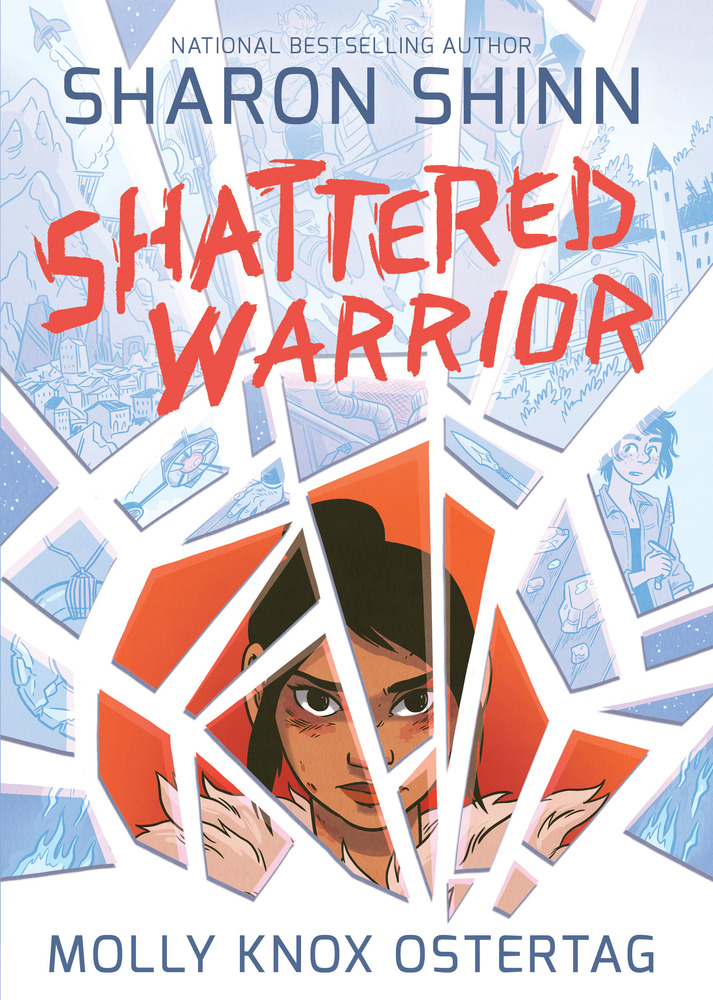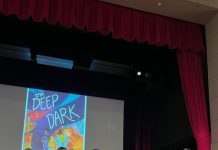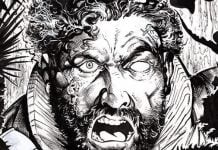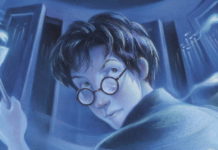
Science fiction writer Sharon Shinn (Twelve Houses series) and writer illustrator Molly Ostertag have combined to create an emotionally resonant story in which a young woman who has lost everything—family, fortune and home—must learn to trust and love again in order to brave a hostile world. The Beat caught up with Ostertag to chat about Shattered Warrior, star-gazing (Comic-Con style) and news about upcoming projects.
Comics Beat (CB): I read Shattered Warrior and really loved it.
Molly Ostertag (MO): Awesome.
CB: Can you talk about the approach you used in working with Sharon Shinn. Were you familiar with her novels before you started the project?
MO: I had not read any of her books before I started. I had friends who had read them, so I read a few based on their recommendations to get a feel for what her stories were all about. It was a couple of years ago at this point, and I can’t remember how it all went, but she sent Mark Siegel at First Second–and I only recently learned from doing a joint interview–a draft for a novel that she never finished and had never wanted to pursue. That was where we started, and I took and adapted it pretty heavily because a novel is very different from a graphic novel in terms of how much you can tell and how much story you can fit in.
CB: I loved how emotive the scenes were, even though there wasn’t a lot of action or movement within the panels.
MO: As an artist I’m much more interested in the emotional story than I am in the action. I think Sharon is probably similar as a writer. It definitely ended up being much more of a romance than an action sci-fi story.
CB: Did you plan it that way?
MO: That was what the book was when I got it. I don’t know, maybe it’s my limit as an artist, but action is hard for me to draw, and it’s just not very interesting. If it was more interesting I’d probably be better at drawing it. I’d rather figure out how to draw people’s feelings in a real way.
CB: How was working on Shattered Warrior different from working on a webcomic like Strong Female Protagonist or one of your shorter comics?
MO: It was different because this was the first comic that Sharon had done that was a draft of a novel. So there was a lot of slimming down scenes. With novels, a lot more time can pass, and a lot more things can happen which you describe quickly, whereas it’s harder to show that passing of time in a graphic novel in a way that is felt. You have less mileage for the thought, so a lot of it was finding the emotional threads and the key scenes from the plot and writing those.
With Strong Female Protagonist I deal with a writer and it’s our thing. I have a lot more input into that story. We brainstorm chapters together. Brennan Lee Mulligan [the writer] writes them. Then with Scholastic, I wrote and drew Witch Boy, which is coming out this fall and was an interesting process. It was seamless. I knew already that I was telling a story that would fit into a graphic novel. I think with every writer I’ve worked on, and maybe this is a reflection on me as an artist, we’re trying to do little bit too much. I can’t draw all of this, and so we have to slim it down.
CB: How much of the back-and-forth, collaborative process occurred between Sharon and yourself?
MO: Mark Siegel sent me a full document that was a description of all the characters and all the factions in the world: the Chromatti, the Derichet, and the Valenchi. It was a draft of a rough novel–maybe a little shorter than a novel. I adapted it into a script and we had a lot of back and forth to figure out what parts were key for Sharon, what parts needed to be said, and what parts could be cut, to figure out how to trim it into a graphic novel. Mark Siegel, our editor, was involved in that a lot.
CB: Turning to yourself, what artists have been the most influential on your artistic style and approach?
MO: As soon as somebody asks that I forget the names of every single person!
I really like Faith Erin Hicks, who is a First Second mainstay, for sure. Her style was really inspiring to me when I read her webcomics as a teenager. I really love Emily Carroll. She has this stylish graphic style that I find really inspiring.
I think some artists try to make comics like they’re making a movie, but they can only make a comic. Artists like Emily Carroll make it this thing that could only be a comic in that it has this graphic quality. I love her look. There are fantasy classics like Moebius that has this immersive world, and I guess Jeff Smith of Bone. People who made these classic fantasy comics that had a detached world that you could lose yourself in…that is really something impressive to me because it’s hard to draw a detailed background and to draw an immersive environment. They always do it so well.
CB: I’ll be honest…when I first started reading Shattered Warrior, Faith Erin Hicks was the first artist I thought of.
MO: I like her. She’s really a great person. It was nice to see an artist in high school who was doing a graphic novel for a kid. It seemed like she was enjoying and really having fun with the medium. There are not a lot of people doing young adult graphic novels, and it’s inspiring.
CB: I know you haven’t spent too much time here so far, but of all the artists that will be here, are there some that you really want to read?
MO: I don’t know if I have any. I’m really just here to do panels. I’m really excited to see all the people on my panels.
I prefer to walk around comic conventions because you could discover new people. This show is a little harder to discover new comics. With San Diego, I usually just go in and do my panels, and see my friends. It’s such a crazy place.
I like graphic novels. I like webcomics. I like indie comics. They’re represented here, but a little harder to find.
CB: Shattered Warrior ends on a happy, cliff-hanging note. What can we expect in future sequels, if there are any?
MO: We don’t have any plans for a sequel at this time. I don’t know. I have a thought about fantasy books, where the condition is for everything to end and get fixed. For me, that’s the ending of the book. The idea that you’ve struck the first blow in the war, and you’ve started the path towards the world improved. You have a lot of work in that. The idea of a Lord of the Rings pat ending–the ring is destroyed, Aragon is king, they go back to the Shire, they clear the Shire–every single thread gets wrapped up until you can rest knowing everything in the world is fine. That’s a very classic fantasy thing. But I think I’m a bit uneasy about that…we started the work, but we still have work to do.
CB: That’s a good approach.
MO: Yeah.
CB: What else can we expect to see from Molly Ostertag in the future?
MO: The book I’m really excited about is Witch Boy from Scholastic Graphix, coming out on Halloween of this year. It’s about a family of people who do magic. The women are all witches and the men are shapeshifters. It’s about a young boy named Aster who is a witch. His family doesn’t quite get it, and it’s about him proving himself. That’s the first book I’ve written and drawn, and that was a really validating experience for me to write my own story. Every piece of it is me, and that’s really cool. It’s personal and close to my heart, so I’m excited about that.
CB: If you don’t mind me asking, how old are you?
MO: I’m 25 (laughing). I’ve drawn a lot of comics.
CB: Did you start in high school?
MO: Yeah, casually drawing in high school. Then I went to the School of Visual Arts. I drew Strong Female Protagonist six years ago. Shattered Warrior was the first book I did right out of school.
CB: Is there a writer that you’d most like to work with in the future?
MO: Honestly, I’m just sort of doing my own thing now. I really enjoy drawing stories for other people writing them, and I feel I’ve learned a lot. But I have a lot of ideas for stories that I’ve been too shy to write. And I’m feeling confident enough to do that, so my plan going forward is to write my own stuff.
CB: It you had the opportunity to draw for Faith Erin Hicks, would you do it?
MO: I don’t know. She wrote a Lumberjanes piece. I like her a lot, but I think I would just do my own thing.
Comics are very difficult to make. They don’t pay very well, and I get arm injuries from drawing. So if I’m going to make a comic at this point going forward I want it to be my comic, and I want it to be my characters and my story. Maybe I’ll change my mind in the future. Right now, that’s the place I’m at.







